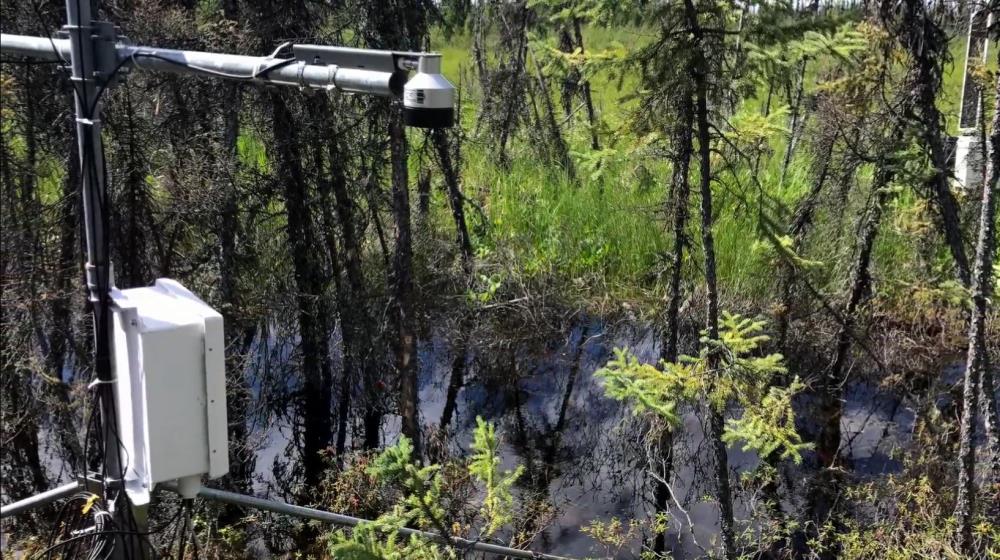
Related items loading ...
Section 1: Publication
Publication Type
Thesis
Authorship
Abdelhamed, Mohamed Safaaeldin Moustafa
Title
Towards Improved Hydrologic Land-Surface Modelling To Represent Permafrost
Year
2023
Publication Outlet
USASK Harvest - Theses and Dissertations
DOI
ISBN
ISSN
Citation
Abdelhamed, Mohamed Safaaeldin Moustafa (2023) Towards Improved Hydrologic Land-Surface Modelling To Represent Permafrost, USASK Harvest - Theses and Dissertations,
https://hdl.handle.net/10388/14972
Abstract
Permafrost affects hydrological, meteorological, and ecological processes in over one-quarter of the land surface in the Northern Hemisphere. Permafrost degradation has been observed over the last few decades and is projected to accelerate under climatic warming. However, simulating permafrost dynamics is challenging due to process complexity, scarcity of observations, spatial heterogeneity, and permafrost disequilibrium with external climate forcing. Hydrologic-land-surface models (H-LSMs), which act as the lower boundary condition of the current generation of Earth system models (ESMs), are suitable for diagnosing and predicting permafrost evolution, as they couple heat and water interactions across soil-vegetation-atmosphere interfaces and are applicable for large-scale assessments. This thesis aims to improve the ability of H-LSMs to simulate permafrost dynamics and concurrently represent hydrology. Specific research contributions are made on four fronts: (1) assessing the uncertainty introduced to the modelling due to permafrost initialization, (2) investigating the sensitivity of permafrost dynamics to different H-LSM parameters, associated issues of parameter identifiability, and sensitivity to external forcing datasets, (3) evaluating the strength of permafrost-hydrology coupling in H-LSMs in data-scarce regions under parameter uncertainty, and (4) assessing the fate of permafrost thaw and associated changes in streamflow under an ensemble of future climate projections. The analyses and results of this thesis that illuminate these central issues and various solutions for permafrost-based applications of H-LSMs are proposed. First, uncertainty in model initialization determines the length of required spin-up cycles; 200-1000 cycles may be required to ensure proper model initialization under different climatic conditions and initial soil moisture contents. Further, the uncertainty due to initialization can lead to divergent permafrost simulations, such as active layer thickness variations of up to ~2m. Second, the sensitivity of various permafrost characteristics is mainly driven by surface insulation (canopy height and snow-cover fraction) and soil properties (depth and fraction of organic matter content). Additionally, the results underscore the difficulties inherent in H-LSM simulation of all aspects of permafrost dynamics, primarily due to poor identifiability of influential parameters and the limitations of currently-available forcing data sets. Third, different H-LSM parameterizations favor different sources of data (i.e. streamflow, soil temperature profiles, and permafrost maps), and it is challenging to configure a model faithful to all data sources. Overall, the modelling results show that surface insulation (through snow cover) and model initialization are primary regulators of permafrost dynamics and different parameterizations produce different low-flow but similar high-flow regimes. Lastly, severe permafrost degradation is projected to occur under all climate change scenarios, even under the most optimistic ones. The degradation and climate change, collectively, are likely to alter several streamflow signatures, including an increase of winter and summer flows. Permafrost fate has strategic importance for the exchange of water, heat, and carbon fluxes over large areas, and can amplify the rate of climate change through a positive feedback mechanism. However, existing projections of permafrost are subject to significant uncertainty, stemming from several sources. This thesis quantifies and reduces this uncertainty by studying initialization, parameter identification, and evaluation of H-LSMs, which ultimately lead to configuring an H-LSM with higher fidelity to assess the impact of climate change. As a result, this work is a step forward in improving the realism of H-LSM simulations in permafrost regions. Further research is needed to refine simulation capability, and to develop improved observational datasets for permafrost and their associated climate forcing.
Plain Language Summary


 GWFNet
GWFNet Master
Master Data
Data Research
Research Map
Map
 Advanced
Advanced Tools
Tools
 . . .
. . .
 Metadata Editor
Metadata Editor
 Record List
Record List
 Alias List Editor
Alias List Editor
 Legacy sites
Legacy sites